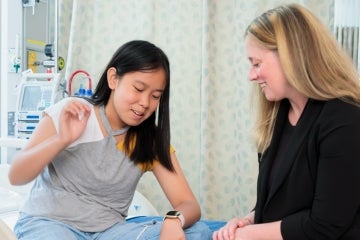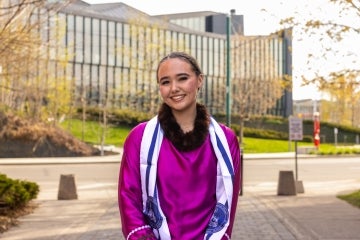IMAGINE: A student-run health clinic treats Toronto’s underserved

Published: November 23, 2018
Every Saturday morning, U of T student volunteers from across health-care professions provide drop-in services to people in Toronto who are underserved or homeless – no ID or provincial health card required.
With the support and guidance of volunteer clinical preceptors, students from the faculties of nursing, pharmacy, medicine, social work, and physiotherapy provide care to patients with acute needs such as wound care, medication management, chronic condition assessment, and harm reduction. Many patients also come away with a care plan that includes referrals to other services.
The clinic is called IMAGINE – a bright-sounding acronym drawn from the lengthier Interprofessional Medical and Allied Groups for Improving Neighbourhood Environments – and has been operating in the Queen West neighbourhood in downtown Toronto since 2010.
“The unmet need was very eye-opening”
“The goal is to provide accessible health care to anyone who is unable to access the regular system,” says Mishaal Arshad, a recent graduate from U of T’s Leslie Dan Faculty of Pharmacy, and former co-director of the IMAGINE clinic.
Arshad, who worked in the clinic in various roles over four years while studying for her Doctor of Pharmacy degree, was struck by the volume and variety of patients who came in for care.
“It was surprising to see how many people don’t have access to health care. You would think the health-care system should be providing care for everyone, but the fact remains that we get about ten patients every Saturday, and the clinic has been running for nearly ten years,” she says.
“That’s a significant number of people we’ve been able to serve. The unmet need was very eye-opening for me.”
The hands-on, inter-professional experience was also invaluable, says Arshad.
“It was incredible to see how different clinicians can work together. There’s so much overlap in our professions and so many more resources to access when we work together,” she says.
Starting at 10 a.m., patients can register for care in a boardroom above the clinical space. The group then gathers and discusses which professional area should take the lead based on the patient’s needs – nursing and social work, for example, for a patient who is homeless and needs a wound to be treated and patched. The preceptors – U of T faculty members and licensed health-care professionals – review the care plan created by the students who then return to the patient to provide care.
Along with the students who provide care and manage the clinic, there is also a group responsible for visiting local shelters to get the word out about the clinic.
Led by students
Collaboration across health disciplines was central to the vision of the original founders of the clinic, initially co-led by students from the Faculty of Pharmacy and Faculty of Medicine.
Getting the clinic off the ground was a significant amount of work, says Marie Rocchi associate professor, teaching stream, at the Faculty of Pharmacy, and one of the original faculty advisors who helped launch the project.
“The idea was born out of a small group of students. They had a clear vision and they made it happen with a lot of grace and intellect, despite the inevitable setbacks and challenges,” she says.
From the early stages, the IMAGINE team wanted to avoid duplicating work that was already happening through community-based services – and organizers say its focus on education and collaboration makes the program unique.
“Yes, we are ultimately focused on improving patient health, but we also want to find as many ways as possible to humanize the health-care experience for patients,” says Dr. Fok-Han Leung. An associate professor with U of T’s department of family and community medicine and long-time volunteer preceptor at the clinic, Dr. Leung is also a family physician at St. Michael’s Hospital.
“To me this is what the art and science of health care is all about – how do we take the science and connect it to the human person? It is this kind of setting that allows us to guide our students in that journey, and to really show how they can make a difference and how they can work together at this very foundational time in their careers.”
Time to scale up
As the IMAGINE clinic nears its ten year anniversary, Arshad and a small group of U of T alumni who contributed to the clinic are working to expand its reach. With help from Dr. Leung, the group was awarded a Communities of Interest grant from the Canadian Medical Association (CMA) this year to build on and expand the work of the IMAGINE clinic.
Along with supporting clinics in other cities where universities and institutions provide health-care education, the goal is to create a platform and network of resources to enable collaboration and knowledge sharing to ease the burden on individual care providers and promote sustainable change in the health system.
“As students we fell in love with what we were doing through this ‘club’ and it propelled us into this larger vision of a not-for-profit organization that could help set up clinics like this in other areas of the country,” says Arshad. “Our blue sky vision is that we will help break down barriers to health care across Canada while also providing high-quality student learning experiences.”
Celebrating U of T’s emerging leaders
On Nov. 6, Arshad received the Susan J. Wagner Student Leadership Award from U of T’s Centre for Interprofessional Education. The award recognizes one student from among 11 health sciences programs who has demonstrated leadership, dedication and excellence through promotion and engagement of inter-professional education and care.
“This is an incredible honour,” says Arshad. “I hope our work at IMAGINE continues to inspire change and ways to create accessible health care across the country.”


